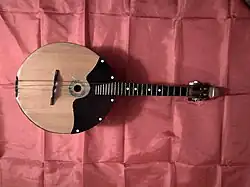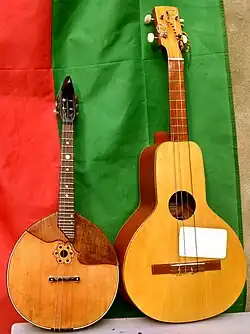Domra
| String instrument | |
|---|---|
| Classification | Plucked string instrument |
| Hornbostel–Sachs classification | 321.321 (Composite chordophone) |
| Playing range | |
 | |
| Related instruments | |
| Balalaika, mandolin | |
The domra (Russian: домра, Russian pronunciation: [ˈdɔmrɑ], pl. домры, domry) is a long-necked Slavic folk string instrument of the lute family.[1][2] It has a round body and three or four metal strings.
Name
According to A. S. Famintsyn, domra is the russified form of Arabic tanbura.[3]
History
The first known written mention of the domra is in Admonitions of Metropolitan Daniel (1530).[4] This musical instrument gained great popularity in the 16th–17th centuries, replacing the gusli.[5] There are numerous mentions of the domra in historic documents of this period.[6] For instance, Alphabet (1654), in the Moscow Synodal Library, says: "As to what musikiia is: Musikiia, playing, that is, the sounding of gusli and kiniry, or lyres, and domry, and similar things".[3]
In addition, medieval Russian illuminated manuscripts of the Psalter contain images of musicians with necked plucked-string instruments, and some of those miniatures are clearly captioned "depiction of domras". Judging by those images, late medieval Russian domry can be divided into two types: lute-shaped, which had five to six strings, a large body and а pegbox angled back, and tanbur-shaped, which had three to four strings, a small body and a straight pegbox.[7]
After the pious Tsar Alexis of Russia issued an edict ordering the persecution of Russian folk musicians and destruction of their instruments (1648), the domra gradually came into disuse and was replaced by the balalaika, which was much easier to make and play.[8] According to the edict:[9]
Whenever domras appear, they should be confiscated and, after those objects of demonic games are broken, burned. And people who play them should be beaten and sent to the end of our state.
In 1896, a student of Vasily Vasilievich Andreyev found a broken instrument in a stable in rural Russia. It was thought that this instrument may have been an example of a domra, although at that time no illustrations or examples of the traditional domra were known to exist (the traditional domra was only known through numerous mentions in folklore, though examples existed of the dombra, a related Turkic instrument). A three-stringed version of this instrument was later redesigned in 1896, patented, and introduced into the orchestra of Russian folk instruments.[10]
Orchestral instruments


The basic domra is tuned as follows:
Instruments are made in various sizes including piccolo, prima, alto, tenor, bass, and contrabass.
- Piccolo: b1 e2 a2[11]
- Prima: e1 a1 d2[12]
- Mezzo-Soprano: b e1 a1[13]
- Alto: e a d1[14]
- Tenor: B e a[15]
- Bass: E A d[16]
- Contrabass (minor): 1E 1A D[17]
- Contrabass (major): 1A D G[18]
Performers
Tamara Volskaya is considered to be one of the leading contemporary performers on the domra.[19]
Aleksandr Tsygankov is considered to be one of the leading contemporary performers, teachers, and composers of the 3 string domra.[20]
See also
References
- ^ Kennedy, Joyce (21 May 2013). "domra". The Oxford Dictionary of Music. Oxford University Press. ISBN 978-0-19-957810-8.
- ^ Libin, Laurence (2015). "Domra". The Grove Dictionary of Musical Instruments. Oxford University Press. ISBN 978-0-19-974339-1.
- ^ a b Findeizen 2008, "7. A Survey of Old Russian Folk Instruments".
- ^ Imkhanitskii 2018, p. 105.
- ^ Imkhanitskii 2018, p. 134.
- ^ Imkhanitskii 2018, p. 135–136.
- ^ Imkhanitskii 2018, p. 139–153.
- ^ Imkhanitskii 2018, p. 153–156.
- ^ Prokhorov, Vadim (8 January 2002). Russian Folk Songs: Musical Genres and History. Bloomsbury Publishing PLC. p. 13. ISBN 978-1-4617-0182-8.
- ^ "Государственный академический русский оркестр им. В. В. Андреева" [State Academic Russian Orchestra. V. V. Andreeva]. Andreyev Orchestra. Russia. Retrieved 30 January 2021.
- ^ "Tablature for piccolo domra". Balalajka.dk.linux20.unoeuro-server.com.
- ^ "Tablature for prima domra". Balalajka.dk.linux20.unoeuro-server.com.
- ^ "Tablature for mezzosoprano domra". Balalajka.dk.linux20.unoeuro-server.com.
- ^ "Tablature for alto domra". Balalajka.dk.linux20.unoeuro-server.com.
- ^ "Tablature for tenor domra". Balalajka.dk.linux20.unoeuro-server.com.
- ^ "Tablature for bass domra". Balalajka.dk.linux20.unoeuro-server.com.
- ^ "Tablature for contrabass domra (the minor)". Balalajka.dk.linux20.unoeuro-server.com.
- ^ "Tablature for contrabass domra (the major)". Balalajka.dk.linux20.unoeuro-server.com.
- ^ Bentel, John (January 1998). "Musicians Relax, Invigorate Audience". State Magazine. No. 410. Department of State. p. 51.
- ^ "Alexander Tsygankov and Inna Shevchenko". Gragroup.com. Retrieved 30 January 2021.
Bibliography
- Findeizen, Nikolai (7 February 2008). History of Music in Russia from Antiquity to 1800, Volume 1: From Antiquity to the Beginning of the Eighteenth Century. Indiana University Press. ISBN 978-0-253-02637-8.
- Imkhanitskii, Mikhail I. (2018). Istoriia ispolnitel'stva na russkikh narodnykh instrumentakh (The history of performance on Russian folk instruments). Moscow: Gnessin State Musical College.